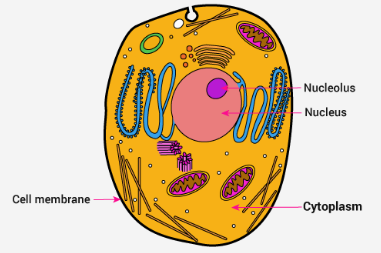The cytoplasm is one of the major elements that constitute the structure of a cell. The basic unit of life in a living organism is the cell. Learning about the functions and structure of the cytoplasm will help gain a better understanding of the cell.
Let us learn more about the cytoplasm’s functions, structures, and history to grasp a clear perception of it.
What is Cytoplasm?
A cell composes different parts and elements that carry out specific functions. One such part of a cell is the cytoplasm. The cytoplasm is found in every living cell, be it an animal cell or plant cell.
Cytoplasm is a thick semi-fluid solution that encloses the cell membrane. The appearance of the cytoplasm is jelly-like because it mainly consists of water, enzymes, nucleic acid, organic molecules, etc. The liquid portion inside the cytoplasm is the cytosol. Various organelles with different structures and functions exist inside the cytoplasm.
The color of the cytoplasm element is clear. The functioning of the cytoplasm is highly organized. In eukaryotic cells, the cytoplasm is the location of all organelles inside a cell. Examples of organelles present inside a cytoplasm include mitochondria, endoplasmic reticulum, Golgi apparatus, ribosomes, etc.
History of Cytoplasm
Robert Hooke, an English scientist, in the 17th century discovered the existence of cells. Thus, we came to know how cells are the fundamental unit of life in all living beings. As the scientific world progressed, Hooke’s discovery was a turning point in the field of natural science.
After identifying cells, numerous scientists carried on the research, and later the Cell Theory came into existence. The cytoplasm in a cell was discovered by a Swiss scientist named Rudolf von Kölliker in the 19th century.
Earlier and even now, under certain references, the cytoplasm is considered a synonym for protoplasm. The origin of the word Cytoplasm is Greek. ‘Cytoplasm’ is derived from Greek words Kytos, meaning hollow, and Plasma, meaning something molded or created.
The bond of the two Greek words denotes the structure of the Cytoplasm. The Cytoplasm is molded around the nucleus of a cell in the form of a thick liquid solution. It is present in between the cell membrane and nucleus.
Structure of Cytoplasm
The cytoplasm is the location where all the organelles inside a cell are implanted. Cytoplasm acts as a medium between the nucleus and cell membrane in its thick liquid-like form. The parts of the cytoplasm are divided into two based on their nature and functions;
- Ectoplasm or Cell Cortex
Ectoplasm exists on the outer part of the cytoplasm. The nature of ectoplasm is rigid, more condensed, and less gritty. The location of ectoplasm is at the peripheral part of the cytoplasm. The ectoplasm lies close and beneath the cell membrane.
- Endoplasm
Endoplasm’s location is more on the central part of the cytoplasm. In comparison to Ectoplasm, endoplasm is less condensed. Since endoplasm is situated in the inner part of the cytoplasm, it lies in between the ectoplasm and the nucleus. Endoplasm is also the area where most organelles are located.
Components of Cytoplasm
The components of a cytoplasm differ in eukaryotic and prokaryotic cells. In eukaryotic cells, the cytoplasm consists of three components;
- Cytosol – The thick semi-fluid liquid present in a cell’s cytoplasm.
- Organelles – Cell structures located inside the cytoplasm that perform several important functions inside a cell. Examples of organelles that are present inside a eukaryotic cell are as follows;
- Plastids
- Mitochondria
- Centrioles
- Endoplasmic Reticulum
- Chloroplast
- Golgi Apparatus
- Lysosomes
- Peroxisomes
- Centrosome
- Ribosome
3. Cytoplasmic Inclusion – Suspended particles of granules and macromolecules inside the cytoplasm. Cytoplasmic inclusion can be further divided into three types;
- Secretory Inclusions: Examples include proteins, enzymes, and acids.
- Nutritive Inclusions: Examples include Glycogen and Lipids.
- Pigment Granules: Examples include melanin – found in skin cells.
Prokaryotic cells are membrane-bound cells. There is an absence of a nucleus inside a prokaryotic cell. The location of all the components of a prokaryotic cell is inside the plasma membrane of the cytoplasm.
Function of Cytoplasm
The primary functions of the cytoplasm are organic. The cytoplasm is responsible for holding various organelles of the cell inside. The fatty membrane of the fluid mass called cytosol of the cell inside the cytoplasm contains all the organelles inside.
The functions of the cytoplasm are mechanical. The cytoplasm assists in the metabolic process of the cell. It is responsible for the movement, entry, and exit of calcium ions.
The cytoplasm aids the suspension of organelles it holds inside. Moreover, it helps the cell membrane sustain the shape and uniformity of the cell.
Cytoplasm Diagram
The diagram of the cytoplasm enables us to understand the location of the cytoplasm as well as its structure and components. Functions of the cytoplasm are also justified when we see the cytoplasm digram. By observing the cytoplasm diagram, we can understand the role and importance of the cytoplasm inside a cell.


